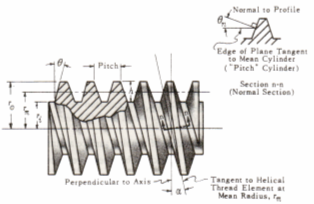Power Screw.xls

Description
Purpose of calculation: For an applied load on a screw thread calculate the axial thrust of a nut. Calculate bolt pretension from screw parameters (thread pitch, thread coefficient of friction, head coefficient of friction etc.).
To perform power screw calculations, the following steps can be taken:
a) Determine Screw Parameters:
- Screw Pitch (P): The distance between adjacent threads on the screw. It can be calculated by dividing the axial movement per revolution by the number of threads.
- Lead (L): The axial movement of the screw per revolution. It is equal to the pitch multiplied by the number of threads.
- Thread Depth (h): The distance from the crest to the root of the thread. It depends on the screw design and can be obtained from standard screw design tables.
- Mean Pitch Diameter (D): The average diameter of the screw thread. It can be calculated by subtracting twice the thread depth from the outer diameter of the screw.
- Helix Angle (?): The angle formed between the helix of the screw thread and the axis of the screw. It can be calculated using trigonometric functions based on the lead and mean pitch diameter.
b) Estimate Starting Torque:
- Determine the Running Friction Torque (Tr): Calculate the torque required to overcome the running friction using the known diameter, running friction coefficient, and axial load.
- Estimate the Starting Friction Torque (Ts): Multiply the running friction torque by a factor of 1.33 to account for the higher starting friction.
- Add the Starting and Running Friction Torques to obtain the total Starting Torque (Tstart).
It is important to note that power screw calculations can involve additional factors and considerations, such as efficiency, lubrication, and system dynamics. These can affect the accuracy of the calculations, and it is advisable to consult relevant standards, references, or professional engineering expertise to ensure accurate and reliable results.
Calculation Reference
Schaum's Outline - Machine Design
Calculation Preview
Full download access to any calculation is available to users with a paid or awarded subscription (XLC Pro).
Subscriptions are free to contributors to the site, alternatively they can be purchased.
Click here for information on subscriptions.

